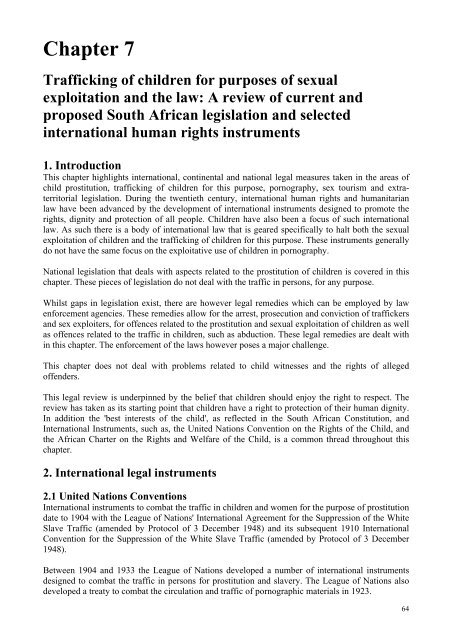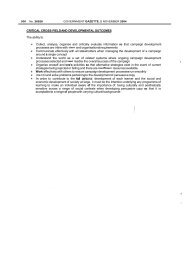The trafficking of children for purposes of sexual exploitation
The trafficking of children for purposes of sexual exploitation
The trafficking of children for purposes of sexual exploitation
Create successful ePaper yourself
Turn your PDF publications into a flip-book with our unique Google optimized e-Paper software.
Chapter 7<br />
Trafficking <strong>of</strong> <strong>children</strong> <strong>for</strong> <strong>purposes</strong> <strong>of</strong> <strong>sexual</strong><br />
<strong>exploitation</strong> and the law: A review <strong>of</strong> current and<br />
proposed South African legislation and selected<br />
international human rights instruments<br />
1. Introduction<br />
This chapter highlights international, continental and national legal measures taken in the areas <strong>of</strong><br />
child prostitution, <strong>trafficking</strong> <strong>of</strong> <strong>children</strong> <strong>for</strong> this purpose, pornography, sex tourism and extraterritorial<br />
legislation. During the twentieth century, international human rights and humanitarian<br />
law have been advanced by the development <strong>of</strong> international instruments designed to promote the<br />
rights, dignity and protection <strong>of</strong> all people. Children have also been a focus <strong>of</strong> such international<br />
law. As such there is a body <strong>of</strong> international law that is geared specifically to halt both the <strong>sexual</strong><br />
<strong>exploitation</strong> <strong>of</strong> <strong>children</strong> and the <strong>trafficking</strong> <strong>of</strong> <strong>children</strong> <strong>for</strong> this purpose. <strong>The</strong>se instruments generally<br />
do not have the same focus on the exploitative use <strong>of</strong> <strong>children</strong> in pornography.<br />
National legislation that deals with aspects related to the prostitution <strong>of</strong> <strong>children</strong> is covered in this<br />
chapter. <strong>The</strong>se pieces <strong>of</strong> legislation do not deal with the traffic in persons, <strong>for</strong> any purpose.<br />
Whilst gaps in legislation exist, there are however legal remedies which can be employed by law<br />
en<strong>for</strong>cement agencies. <strong>The</strong>se remedies allow <strong>for</strong> the arrest, prosecution and conviction <strong>of</strong> traffickers<br />
and sex exploiters, <strong>for</strong> <strong>of</strong>fences related to the prostitution and <strong>sexual</strong> <strong>exploitation</strong> <strong>of</strong> <strong>children</strong> as well<br />
as <strong>of</strong>fences related to the traffic in <strong>children</strong>, such as abduction. <strong>The</strong>se legal remedies are dealt with<br />
in this chapter. <strong>The</strong> en<strong>for</strong>cement <strong>of</strong> the laws however poses a major challenge.<br />
This chapter does not deal with problems related to child witnesses and the rights <strong>of</strong> alleged<br />
<strong>of</strong>fenders.<br />
This legal review is underpinned by the belief that <strong>children</strong> should enjoy the right to respect. <strong>The</strong><br />
review has taken as its starting point that <strong>children</strong> have a right to protection <strong>of</strong> their human dignity.<br />
In addition the 'best interests <strong>of</strong> the child', as reflected in the South African Constitution, and<br />
International Instruments, such as, the United Nations Convention on the Rights <strong>of</strong> the Child, and<br />
the African Charter on the Rights and Welfare <strong>of</strong> the Child, is a common thread throughout this<br />
chapter.<br />
2. International legal instruments<br />
2.1 United Nations Conventions<br />
International instruments to combat the traffic in <strong>children</strong> and women <strong>for</strong> the purpose <strong>of</strong> prostitution<br />
date to 1904 with the League <strong>of</strong> Nations' International Agreement <strong>for</strong> the Suppression <strong>of</strong> the White<br />
Slave Traffic (amended by Protocol <strong>of</strong> 3 December 1948) and its subsequent 1910 International<br />
Convention <strong>for</strong> the Suppression <strong>of</strong> the White Slave Traffic (amended by Protocol <strong>of</strong> 3 December<br />
1948).<br />
Between 1904 and 1933 the League <strong>of</strong> Nations developed a number <strong>of</strong> international instruments<br />
designed to combat the traffic in persons <strong>for</strong> prostitution and slavery. <strong>The</strong> League <strong>of</strong> Nations also<br />
developed a treaty to combat the circulation and traffic <strong>of</strong> pornographic materials in 1923.<br />
64
















